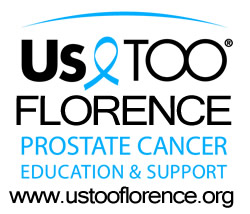|
||||||||
| Home | News You Can Use |
About Us TOO Florence |
Personal Journeys | Slideshows | Contact Us | |||
| Each man's Journey is listed under his BASIC treatment. When you click on one of the names to read a particular Journey, you may see one or more different treatments in bold lettering immediately above the Journey text. You will see (Recurrence) if they are due to a recurrence. Otherwise, they will be treatments used in conjunction with the basic treatment, i.e. Lupron with External Beam Radiation or External Beam Radiation with HDRT/Brachytherapy, etc. | |
Active Surveillance Alternative (Natural) Therapy Cryoablation - Freezing Hormone Therapy Radiation - Brachytherapy Radiation - External Beam Radiation - HDRT Surgery - Open Surgery - Robotic |
My experience with prostate cancer began when my Prostate Specific Antigen (PSA) blood test requested by Dr. Naqvi in July of 2008 came back at 6.5. Concerned that such a high PSA number like 6.5 increased the possibility of prostate cancer, Dr. Naqvi referred me to urologist Dr. Bryan Mehlhaff. My PSA number was of greater concern in my case than with many men because I had prostate cancer in my family. My father had it, but died of heart failure, and I lost an uncle to it in 1963. Family history and my age (80) are two of the risk factors for prostate cancer. A history of my PSA scores reads as follows: 1994 (1.8), 1996 (2.3), 1998 (2.6), 1999 (3.6), 2002 (2.8), July 2008 (6.5), August 2008 (7.9), and Dec. 2008 (9.2). I didn't undergo any PSA tests from 2002 to July 2008 because my doctor in Eugene didn't suggest them and neither did I. Knowing what I know now about family history and prostate cancer, I realize I should have been much more diligent about getting annual PSA tests. One thing is for sure, the rapid increase in my PSA from July 2008 to December 2008 was not good news. I know now that the rate of increase (velocity) in one's PSA can be a more significant sign of prostate cancer than the PSA number itself and can also be an indicator of the aggressiveness of the cancer . How do you determine PSA velocity? By getting annual PSA tests and comparing the numbers year to year. In addition to my rapidly increasing PSA scores, Dr. Mehlhaff found a lump on my prostate during the digital rectal exam (DRE) and scheduled a biopsy (the only way to positively diagnose prostate cancer). The results showed the presence of cancer in 50 percent of the prostate samples that were taken and a Gleason score of 7, which placed my cancer as moderately aggressive. This was followed by a whole body bone scan and an MRI to see if the cancer had metastasized outside the prostate. Both were negative. On January 20, Dr. Mehlhaff gave me a hormone shot (Lupron) to weaken the cancer in preparation for the radiation treatment. By March 16, my PSA had dropped from 9.2 in December to 2.9. That was reassuring evidence that the Lupron was doing its job. As all of this was going on, I had started attending the Man-to-Man monthly meetings at the Presbyterian Church of the Siuslaw and encountered approximately 30 men who were in various stages of prostate cancer treatment. What a valuable resource these men were for me! Many factors were considered when choosing my treatment, including my age, general health, life expectancy, aggressiveness of the cancer, and severity of side effects. Dr. Mehlhaff and I considered three options for attacking the cancer: Active surveillance, prostatectomy (surgical removal of the prostate) and external beam radiation therapy. Active surveillance was considered too risky, considering my PSA and Gleason scores and the possibility that the cancer would metastasize to other organs or to my pelvic bones, effectively closing the "window of curability." My first preference was surgical removal (out, out, damned tumor!) . Dr. Mehlhaff, however, favored radiation in consideration of the risks of major surgery at my age. His recommendation was assured when Dr. Day found that I had a blocked carotid artery during the pre-op for my colonoscopy. That has been surgically repaired and my image-guided radiation therapy (IGRT) that will be five days per week for seven weeks started May 4 and is scheduled to end on July 7. This precise radiation therapy is at the Oregon Urology Institute's Radiation Center in Springfield under the direction of Dr. Barry Blyton. My thoughts are that my radiation therapy will cure me of prostate cancer and my eventual death will be from other causes. The approximately 35 round trips to the radiation center in Springfield will utilize the bus service provided by the Friends of Florence, for which I am profoundly grateful. |
| www.ustooflorence.org Copyright © 2010 - 2024 | |

